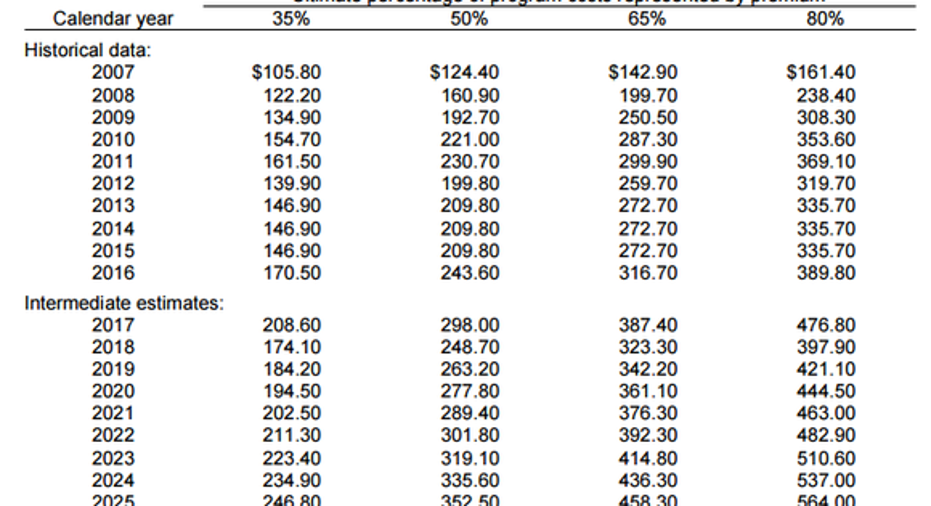Medicare Could Cost You More Than You Think in 2017

Image source: Getty Images.
Medicare Part B premiums could jump to $149 per month for millions of enrollees and they could eclipse $475 per month for high-income Americans in 2017. Will you be among those seniors who see their monthly Social Security income drop because of soaring Medicare premiums?Read on to find out more about how Medicare premiums could impact you next year.
Where we stand today
There are various "parts" to Medicare. Part A covers hospitalizations, Part B covers diagnosing and treating illnesses and preventative healthcare, such as primary care, and Part D covers prescription medicine. There's also Part C, or Medicare Advantage, which can offer a combination of coverage provided by Parts A, B, and D.
In most cases, Medicare recipients aren't charged a premium for Part A, however, monthly premiums are charged to recipients for Part B and Part D, and they can be charged for Part C too, depending on what the plan covers.
Most Medicare Part B costs are subsidizedby tax revenue out of the general fund, but premiums are designed to cover 25% or more of the program's cost, depending on a person's income. Since many recipients pay their Medicare premiums directly out of their Social Security income, recipients can be squeezed when Medicare premiums rise more quickly than annual Social Security cost-of-living increases.
Medicare costs increased this year, but low inflation led the Social Security Administration to forgo a cost-of-living increase. That situation almost resulted in asubstantial premium increase for 30% of Part B enrollees.A hold-harmless provision prevents Medicare premiums from increasing by more than Social Security -- in dollar terms -- for about 70% of Part B recipients, but gaps between premiums collected and costs have to be covered, so Americans who aren't protected by the hold-harmless provision have to make up the difference. As a result, Medicare's board of trustees estimated last year that premiums on Part B enrollees who are unprotected by the hold-harmless provision would have needed to skyrocket to $159.30 in 2016 from $104.90 in 2015.
Fortunately, Washington, D.C. averted that spike in premiums by including a provision in the Bipartisan Budget Act of 2015 that allowed Medicare to borrow money from the general fund, a decision that resulted in Part B premiums for those Americans increasing more modestly to $121.80 this year.
Soaring Medicare premiums in 2017
In June, Medicare's trustees said that a projected 0.2% increase in Social Security income next year would be insufficient to cover the necessary Part B premium increase and thus,Part B premiums could spike for Americans unprotected by the hold-harmless provision again in 2017.
The trustees estimate that average Part B premium payments will need to increase 22% next year to $149 per month to make up the difference between premiums collected and Part B costs and that double digit rate increase means some high income Americans could see their premiums skyrocket next year. Singles who earned more than $85,000 and couples who earned more than $170,000 two years ago areresponsible for 35%, 50%, 65%, or 80% of Medicare Part B costs, depending on their actual income. Therefore, the trustees estimate that the highest income Americans could end up paying over $475 per month for Part B in 2017.
Source: Medicare Board of Trustees annual report.
The big unknown
Part B and Part D costs increased by an annual 5.6% and 7.7%, respectively, over the last five years, and those increases are far greater than inflation. Unfortunately, Medicare's trustees project average annual Part B and Part D growth rates of 6.9% and 10.6%, respectively, over the next five years, so there's a good chance that Medicare premiums will continue to grow more quickly than Social Security income. If so, then many Social Security recipients could end up paying far more in Part B premiums in the future than they imagine.
The $15,834 Social Security bonus most retirees completely overlook If you're like most Americans, you're a few years (or more) behind on your retirement savings. But a handful of little-known "Social Security secrets" could help ensure a boost in your retirement income. For example: one easy trick could pay you as much as $15,834 more... each year! Once you learn how to maximize your Social Security benefits, we think you could retire confidently with the peace of mind we're all after.Simply click here to discover how to learn more about these strategies.
Try any of our Foolish newsletter services free for 30 days. We Fools may not all hold the same opinions, but we all believe that considering a diverse range of insights makes us better investors. The Motley Fool has a disclosure policy.